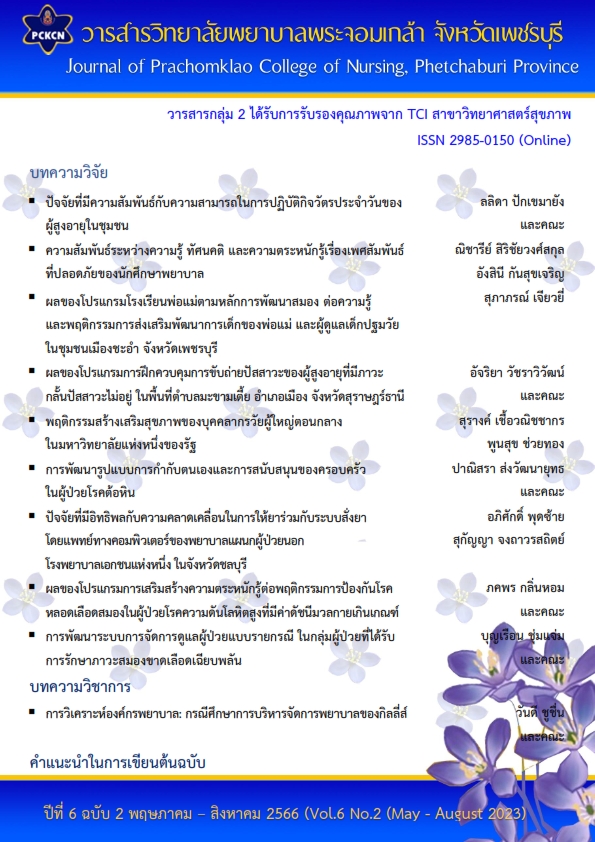พฤติกรรมสร้างเสริมสุขภาพของบุคคลากรวัยผู้ใหญ่ตอนกลาง ในมหาวิทยาลัยแห่งหนึ่งของรัฐ
Main Article Content
บทคัดย่อ
การวิจัยเชิงพรรณนาภาคตัดขวาง มีวัตถุประสงค์เพื่อศึกษาพฤติกรรมสร้างเสริมสุขภาพของบุคลากรวัยผู้ใหญ่ตอนกลาง และความสัมพันธ์ระหว่างปัจจัยส่วนบุคคลและปัจจัยด้านจิตวิทยากับพฤติกรรมสร้างเสริมสุขภาพของบุคลากรวัยผู้ใหญ่ตอนกลาง กลุ่มตัวอย่างเป็นบุคลากรวัยผู้ใหญ่ตอนกลางที่ทำงานในมหาวิทยาลัยแห่งหนึ่งของรัฐ จำนวน 200 คน คัดเลือกกลุ่มตัวอย่างโดยการสุ่มอย่างง่าย เก็บรวบรวมข้อมูลโดยใช้แบบสอบถามปัจจัยส่วนบุคคล ปัจจัยจิตวิทยา ได้แก่ ความรู้สึกมีคุณค่าในตนเอง และความสุข และแบบสอบถามพฤติกรรมสร้างเสริมสุขภาพ ซึ่งมีค่าความเชื่อมั่นสัมประสิทธิ์แอลฟาของครอนบาค เท่ากับ .87, .91, และ .92 ตามลำดับ วิเคราะห์ข้อมูลโดยใช้สถิติเชิงพรรณนา การทดสอบไคสแควร์ และสัมประสิทธิ์สหสัมพันธ์เพียร์สัน ผลการวิจัย พบว่า
1. กลุ่มตัวอย่างมีอายุเฉลี่ย 46.46 ปี (SD = 5.45) เพศหญิง ร้อยละ 67.50 มีการศึกษาในระดับปริญญาโท ร้อยละ 50.50 สถานภาพสมรสคู่ ร้อยละ 46.00 ความพอเพียงของค่าใช้จ่ายต่อเดือน มีเงินพอใช้และเหลือเก็บ ร้อยละ 50.00 ปฏิบัติงานสายวิชาการ ร้อยละ 59.00 มีดัชนีมวลกายตามเกณฑ์ ร้อยละ 59.70ส่วนใหญ่ไม่มีโรคประจำตัว ร้อยละ 78.00 มีพฤติกรรมสร้างเสริมสุขภาพอยู่ในระดับปานกลาง (M = 86.38, SD = 12.85) ความรู้สึกมีคุณค่าในตนเองอยู่ในระดับสูง (M = 78.54, SD = 12.75) และความสุขอยู่ในระดับมาก (M = 4.45, SD = .70)
2. ระดับการศึกษามีความสัมพันธ์กับพฤติกรรมสร้างเสริมสุขภาพ อย่างมีนัยสำคัญทางสถิติ (p < .05) (X2 = 38.95, Cramer’s V = .30) ความรู้สึกมีคุณค่าในตนเอง และความสุขมีความสัมพันธ์ทางบวกในระดับปานกลาง อย่างมีนัยสำคัญทางสถิติที่ระดับ .05 (r = .48, .56 ตามลำดับ)
ผลการวิจัยชี้ให้เห็นว่า มหาวิทยาลัยของรัฐควรมีนโยบายจัดกิจกรรมส่งเสริมพฤติกรรมสร้างเสริมสุขภาพ ความรู้สึกมีคุณค่าในตนเอง และความสุขให้แก่บุคลากรวัยผู้ใหญ่ตอนกลาง และออกแบบกิจกรรมการส่งเสริมสุขภาพให้สอดคล้องกับช่วงวัย
Downloads
Article Details

อนุญาตภายใต้เงื่อนไข Creative Commons Attribution-NonCommercial-NoDerivatives 4.0 International License.
เนื้อหาและข้อมูลที่เผยแพร่ในวารสารวิทยาลัยพยาบาลพระจอมเกล้า จังหวัดเพชรบุรี ถือเป็นข้อคิดเห็นและความรับผิดชอบของผู้นิพนธ์บทความโดยตรง บทความ เนื้อหา ข้อมูล รูปภาพ ฯลฯ ที่ได้รับการเผยแพร่ในวารสารนี้ ถือเป็นลิขสิทธิ์ของวารสารฯ หากบุคคลหรือหน่วยงานใดต้องการนำทั้งหมดหรือส่วนหนึ่งส่วนใดไปเผยแพร่หรือเพื่อกระทำการใด ๆ จะต้องอ้างอิงวิทยาลัยพยาบาลพระจอมเกล้า จังหวัดเพชรบุรี ทุกครั้ง
เอกสารอ้างอิง
Bureau of Non-Communicable Diseases, Ministry of Public Health. (2018). Handbook of risk assessment ischemic heart disease and cerebrovascular disease (paresis, paralysis) for village health volunteer (2nded.). Office of Printing Affairs Veterans Welfare Organization under the Royal Patronage. (in Thai)
Bloom, B. S., & Krathwohl, D. R. (2020). Taxonomy of educational objectives: The classification of educational goals. Book 1, cognitive domain. Longman.
Cherwanitchakorn, S., Shuaytong, P., & Karuhadej, P. (2019). Health promoting behavior among nursing students in Dusit district. The Institute of Research and Development, Suan Sunandha Rajabhat University. (in Thai)
Cherwanitchakorn, S, Shuaytong, P., & Karuhadej, P. (2023). Health promoting behavior among senior high school students in an institute of education. Journal of Prachomklao College of Nursing, Phetchaburi Province, 6(1), 31-45. (in Thai)
Cohen, J. (1988). Statistical power analysis for the behavioral sciences (2nded.). Lawrence Erlbaum Associates.
Coopersmith, S. (1981). The antecedents of self-esteem. W.H. Freeman and Company.
Creation and lifelong learning promotion, Suan Sunandha Rajabhat University. (2017). Human resource management plan 5 years (B.E. 2017-2021). https://cls.ssru.ac.th/useruploads/files/20210322/d0cc0155bb91c675f04df2043fb5755b56867b9c.pdf (in Thai)
Division of Non-communicable Diseases, Ministry of Public Health. (2023, 18 January). Number and mortality rate of 5 NCDs 2017-2021 (diabetes mellitus, hypertension, myocardial infarction, stroke, and chronic obstructive pulmonary disease) per 100,000 population classified to provinces, health areas, and overall country (including Bangkok). http://www.thaincd.com/2016/mission/documents-detail.php?id =14480&tid=32&gid=1-020 (in Thai)
Hui, L. (2017). Assessment of the role of ageing and non-ageing factors in death from non-communicable diseases based on a cumulative frequency model. Scientific reports, 7(1), Article 8159. https://doi.org/10.1038/s41598-017-08539-0
Kasempipatpong, C. (2015). Factors related to health promotion and disease prevention behaviors at Chaophraya Yommarat Hospital. Journal of Health Science, 24(1), 41-49. (in Thai)
Kasemsuk, K., & Ritudom, B. (2023). Health promotion of middle adulthood development: Nurses’ role. Regional Health Promotion Center 9 Journal, 17(1), 368-380. (in Thai)
Natetanon, S., & Korktathong, A. (2020). Model of working – age health promotion in the community at region 5. Primary Health Care Division Journal, 16(2), 8-22. (in Thai)
National Statistical Office, Ministry of Digital Economy and Society. (2021). The 2021 health behavior of population survey. National Statistical Office, Ministry of Digital Economy and Society. (in Thai)
Pasunon, P. (2014). Sample size determination from Krejcie and Morgan (1970): Approach in quantitative research. The Journal of Faculty of Applied Arts, 7(2), 112-120. (in Thai)
Pender, N. J., Murdaugh, C. L., & Parsons, M. A. (2011). Health promotion in nursing practice (6th ed.). Pearson.
Pratoomsuwan, T., & Sawangsopakul, B. (2021). Self esteem, hardiness and self care of high school students at Bodindecha (Sing Singhaseni) 2 School, Bangkok. Journal of the Association of Researchers, 26(1), 374-392. (in Thai)
Rojpaisarnkit, K. (2016). Factors Influencing health promoting behaviors of Thai elderly: A case study of middle old age in Samut Prakan Province. Journal of Nursing Science Chulalongkorn University, 28(3), 68-83. (in Thai)
Saengsinsorn, P. (2021). A study of factors related to health behavior of people at risk of diabetes and hypertension in Phichit Province. Phichit Public Health Research and Academic Journal, 2(2), 43-54. (in Thai)
Shuaytong, P., Suphan, B., Sirimongkhon, S., Karuhadej, P., & Cherwanitchakorn, S. (2014). Levels of happiness and self-esteem of the middle adulthood. Journal of Nursing and Health Suan Sunandha Rajabhat University, 1(2), 11-19. (in Thai)
Solhi, M., Pirouzeh, R., & Zanjari, N. (2022). Perspectives on health ageing in middle age: Evidence for health promotion interventions. Journal of Education and Health Promotion, 11, Article 5. https://www.ncbi.nlm.nih.gov/pmc/articles/PMC8893087/pdf/JEHP-11-5.pdf
Solod, W. (2022). Sedentary behaviors increases the risk factor of developing non-communicable diseases (NCDs): Prevention guidelines. Health Science Journal of Nakhon Ratchasima, 1(2), 42-53. (in Thai)
World Health Organization (WHO). (2022, 16 September). Non-communicable diseases. https://www.who.int/news-room/fact-sheets/detail/noncommunicable-diseases
Womble, D. M., & Kincheloe, C. A. (2020). Introductory mental health nursing (4th ed.). Wolters Kluwer.
Wongkeeree, K. (2021). Exercise behavior of people in Maelanoi district, Mae Hong Son Province [Unpublished master’s thesis]. Thailand National Sports University, Chiang Mai Campus. (in Thai)


